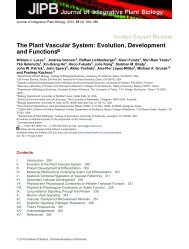Insights into the Witheringia solanacea (Solanaceae ... - BioOne
Insights into the Witheringia solanacea (Solanaceae ... - BioOne
Insights into the Witheringia solanacea (Solanaceae ... - BioOne
Create successful ePaper yourself
Turn your PDF publications into a flip-book with our unique Google optimized e-Paper software.
Crossing Studies in Wi<strong>the</strong>ringia 73<br />
TABLE 1. Sources of Wi<strong>the</strong>ringia plants used in this study. Seeds were collected from a single plant. Number of plants<br />
used in crosses is listed under each accession.<br />
Wi<strong>the</strong>ringia asterotricha. Bohs 2377. Costa Rica: Prov. Limón, Portico logging project near Cariari, ca 1020N,<br />
8345W, ca 50 m elev. Seed accession no. 91-13; 5 plants.<br />
Wi<strong>the</strong>ringia asterotricha. Bohs 3007. Costa Rica: Prov. Heredia, La Selva Biological Station, 1026N, 8359W, Sendero<br />
La Chanchera (SCH) near junction with Camino Experimental Norte (CEN) (approx. grid coordinates 600<br />
100), ca 50–60 m elev. Seed accession no. 90-3; 3 plants.<br />
Wi<strong>the</strong>ringia meiantha. Bohs 3015. Costa Rica: Prov. Heredia, La Selva Biological Station, 1026N, 8359W, Sendero<br />
Oriental (SOR) just past waterfall (approx. grid coordinates 600 1300), ca 40–60 m elev. Seed accession<br />
no. 90-7; 5 plants.<br />
Wi<strong>the</strong>ringia meiantha. Bohs 2387. Costa Rica: Prov. Heredia, La Selva Biological Station, 1026N, 8359W, Sendero<br />
Surá (SUR) at entrance to arboretum (approx. grid coordinates 800 600), ca 40–60 m elev. Seed accession<br />
no. 91-22; 2 plants.<br />
Wi<strong>the</strong>ringia <strong>solanacea</strong>. Bohs 2416. Costa Rica: Prov. Alajuela, Rio La Paz Pequeña, ca 500 m N of Catarata de La<br />
Paz next to road between Puerto Viejo and Vara Blanca, ca 1013N, 8410W, ca 1350–1400 m elev. Seed<br />
accession no. 92-8; 10 plants.<br />
Wi<strong>the</strong>ringia <strong>solanacea</strong>. Bohs 2427. Costa Rica: Prov. Puntarenas, vicinity of Las Cruces Biological Station near San<br />
Vito, margin of road between station and Agua Buena, ca 850N, 8305W, ca 1100 m elev. Seed accession no.<br />
92-13; 10 plants.<br />
Wi<strong>the</strong>ringia meiantha also was found at Las Cruces,<br />
where it was uncommon in light gaps of <strong>the</strong> primary<br />
forest.<br />
MATERIALS AND METHODS<br />
Seeds were ga<strong>the</strong>red from ripe fruits at <strong>the</strong> study<br />
sites described above and plants were grown in pollinator-free<br />
greenhouses at <strong>the</strong> University of Utah.<br />
Sources of plants and voucher information are given<br />
in Table 1.<br />
For <strong>the</strong> artificial crosses, pollen was tapped<br />
onto a clean glass slide and rubbed on <strong>the</strong> stigma<br />
of <strong>the</strong> maternal parent. Plants suspected or determined<br />
to be self-compatible were emasculated in<br />
<strong>the</strong> bud before pollination. Numbers of crosses performed,<br />
number of fruits set, and number of seeds<br />
per fruit are listed in Table 2. ‘‘Sib crosses’’ refer to<br />
crosses involving individuals from a single seed accession,<br />
whereas ‘‘outcrosses’’ refer to crosses between<br />
individuals from different seed accessions. In<br />
crosses yielding fruits, <strong>the</strong> fruit size, color, and seed<br />
number and appearance were recorded. Seeds subsequently<br />
were planted in <strong>the</strong> greenhouse to determine<br />
<strong>the</strong>ir viability and to assess <strong>the</strong> vitality of <strong>the</strong><br />
F 1 plants.<br />
Pollen viability was determined by shaking<br />
grains onto a clean glass slide and staining in aniline<br />
blue-lactophenol (Hauser & Morrison 1964).<br />
Pollen grains were allowed to stain for at least one<br />
hour before scoring. The first 300 grains encountered<br />
were scored, and unshriveled grains staining<br />
blue in <strong>the</strong> preparation were presumed to be viable.<br />
Pollen stainability was measured in all parent<br />
plants, but only a subset of <strong>the</strong> F 1 plants reached<br />
flowering maturity.<br />
Pollen tube growth was observed using <strong>the</strong><br />
technique of Martin (1959) with <strong>the</strong> following<br />
modifications. Flowers were harvested and fixed<br />
48–72 hours after pollination. Gynoecia were <strong>the</strong>n<br />
rinsed and cleared in 0.8 N NaOH at 60C for 1<br />
to 2 hours, rinsed briefly, and stained. At least three<br />
flowers were examined per crossing combination.<br />
Chromosome observations were made from<br />
fresh flower buds ga<strong>the</strong>red from greenhouse-grown<br />
plants. An<strong>the</strong>rs were macerated in a 1.0 percent<br />
acetocarmine solution or in LP orcein (W. Bloom,<br />
pers. comm.), a cover slip was added, and <strong>the</strong> preparation<br />
was squashed. Herbarium vouchers were<br />
deposited at <strong>the</strong> National Museum in San José,<br />
Costa Rica, and at <strong>the</strong> Garrett Herbarium at <strong>the</strong><br />
University of Utah, Salt Lake City. Type specimens<br />
of Acnistus lehmanni Damm., Capsicum asterotrichum<br />
Standl., C. costaricense Standl. & Morton, C.<br />
isothrix Standl., C. multiflorum Standl. & Morton,<br />
C. silvigaudens Standl. & Williams, C. stenophyllum<br />
Morton & Standl., C. tetramerum Standl. & Morton,<br />
Sicklera tetrandra A. Braun & Bouché, and<br />
Solanum panamense van Heurck & Muell.-Arg.<br />
were examined to ensure that my taxonomic concepts<br />
were congruent with those of earlier authors.<br />
These names and types include a majority of <strong>the</strong><br />
nomenclatural and taxonomic synonyms that have<br />
been used for <strong>the</strong> taxa of <strong>the</strong> W. <strong>solanacea</strong> complex.<br />
RESULTS<br />
CHROMOSOME NUMBERS.—Meiotic squashes from<br />
accessions of all three taxa (W. asterotricha: Bohs
















